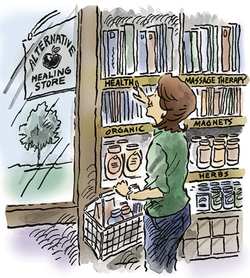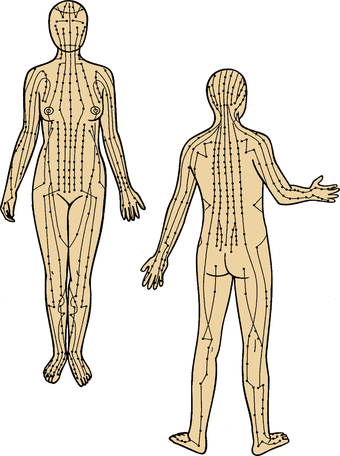Charlotte Eliopoulos, PhD, RN, MPH, ND After studying this chapter, the reader will be able to: 1. Describe various complementary and alternative healing practices. 2. Identify how to effectively incorporate effective complementary and alternative therapies into care. 3. Provide patient education regarding uses, limitations, and precautions associated with selected complementary and alternative healing practices and products. Herbal therapies, individual and orthomolecular biologic therapies, special diets. Complementary and alternative medicine (CAM) Healing philosophies, practices, and products that are outside of what Western society considers mainstream medicine and are not typically taught in the educational programs of physicians, nurses, and other health professionals. Western style of medicine practiced in the United States; also called allopathic medicine. Qi gong, Reiki, therapeutic touch, healing touch, magnet therapy. Manipulative and body-based methods Chiropractic, massage, and related techniques (e.g., manual lymph drainage, Alexander technique, Feldenkrais method, pressure point therapies, Trager psychophysical integration), osteopathy. Aromatherapy, art therapy, biofeedback, dance therapy, hypnosis, imagery, meditation, music therapy, prayer, qi gong, progressive relaxation, self-help support groups, tai chi, yoga. Alexander technique, Feldenkrais method, Rolfing, Trager psychophysical integration. Herbal therapies, individual and orthomolecular biologic therapies, special diets. Ayurvedic medicine, traditional Chinese medicine, traditional healers (e.g., Native American, shamans), environmental medicine, homeopathy, naturopathy. Additional resources are available online at: http://evolve.elsevier.com/Cherry/ VIGNETTE Last year, Ms. Jeffers completed a course in the use of therapeutic touch and has used this therapy to promote relaxation and pain control with friends and family with considerable success. She is aware of many positive reports on the benefits of these unconventional approaches. She believes therapeutic touch and some other complementary healing therapies could benefit clients on the rehabilitation unit and informally introduces the topic to the team with whom she works. With the exception of one nurse who states that she believes these therapies are associated with the occult and wants no part of them, the nursing staff is enthusiastic and eager to implement complementary therapies. The physical and occupational therapists believe that complementary therapies could prove helpful to clients but that only therapists within their departments, not nursing, should provide these. The physician on the team opposes the use of all alternative and complementary therapies, claiming he “isn’t about to put his license on the line for these unproven ideas.” Questions to Consider While Reading This Chapter 1. What is the best course of action for Ruth Jeffers, RN, if she really believes that complementary and alternative therapies could benefit clients on the unit? 2. What would a hospital need to do to prepare for the inclusion of complementary and alternative therapies in its existing services? 4. What discipline(s) should be responsible for providing and/or coordinating or supervising the practitioners who provide complementary and alternative therapies in the hospital? This chapter presents an overview of complementary and alternative medicine (CAM) therapies and products, which have gained popularity in Western society and are being integrated into health care. As increasing numbers of consumers and clinical settings become interested in and actually use CAM therapies, nurses must become knowledgeable about the uses, limitations, and precautions associated with these new practices and products. Professional nurses have an obligation to understand such practices and products to advise patients and effectively incorporate pertinent therapies into patients’ care. Nurses who have knowledge and skills in this area are in key positions to empower patients for self-care that complements conventional medicine. The past few decades have seen CAM progress from a fringe movement to highly popular, widely used therapies that are being integrated into conventional care. According to a nationwide government survey, approximately 38% of U.S. adults 18 years of age and older and approximately 12% of children use some form of CAM, and most are paying for these services out of their own pockets (National Center for Complementary and Alternative Medicine [NCCAM], 2011a). • Dissatisfaction with the conventional health care system: The impersonal nature of health care has grown with costs. Shorter hospital stays, several months’ waiting periods to see a physician, hurried staff that barely have time to provide basic care, and horror stories of the adverse effects of medications are causing consumers to look for alternative approaches that are safer, less costly, and more responsive and personalized than conventional health care. • Increased empowerment of consumers in the health care system: The Internet and growing assertiveness of consumers in all areas has impacted health care. Consumers expect to have a voice in their care-planning activities and be able to utilize all available options for health promotion and disease management, including therapies outside mainstream medicine. • Unwillingness to “grin and bear” the effects of diseases: Today’s consumers are less willing than previous generations to live with symptoms that alter their lifestyles or to passively accept a terminal diagnosis and wait to die. They want options and to be empowered to do everything conceivable to promote the best possible quality and quantity of their lives, and they are willing to look to alternative healing measures to do so. • Shrinking world: The rapid pace and ease of information sharing have enabled individuals to learn about diverse practices of cultures throughout the world. • Growing evidence of effectiveness: The body of research supporting the effectiveness of alternative therapies increases almost daily. People hear testimonials from friends and family about the way they have been helped by acupuncture, herbs, and other forms of CAM. In addition, the media regularly report these findings, contributing to consumers’ awareness of the body of evidence. CAM practices and products are consistent with the values, beliefs, and philosophic orientations toward health held by many people (NCCAM, 2011a). With rare exceptions, consumers prefer natural approaches that afford them an active role in their care over high-tech interventions that relegate them to a passive, obedient role. They want to connect with their health care providers, have their individuality recognized, and gain education and skills to effectively make decisions and direct their care. Increasingly, consumers are seeking measures to enhance not just their bodies, but also their minds and spirits. The quality of their lives is equally if not more important to the quantity of years they live. Consumers often discover that CAM promotes many principles of holistic care that they value, such as individual empowerment, self-care, attention to all facets of one’s being, and a high quality of life. A wide range of healing therapies are encompassed in CAM, yet most share some common principles: • The body has the ability to heal itself. Most conventional medicine works from the premise that the elimination of sickness requires an intervention “done to” the body (e.g., giving medications, surgery). In CAM, there is the assumption that the body has the potential to heal itself. Complementary and alternative healing therapies enhance the body’s ability to self-heal. • Health and healing are related to a harmony of mind, body, and spirit. The mind, body, and spirit are inseparable; what affects one affects all. Healing and the improvement of health demand that all facets of a person be addressed, not merely a single symptom or system. • Basic, positive health practices build the foundation for healing. Good nutrition, exercise, rest, stress management, and avoidance of harmful habits (e.g., smoking) are essential ingredients to health maintenance and the improvement of health conditions. Practitioners of healing therapies are more likely than conventional practitioners to look at total lifestyle practices rather than the diseased body part. • Approaches to healing are individualized. The unique composition and dynamics of each person are recognized in CAM. Practitioners of healing therapies explore the underlying cause of a problem and customize approaches accordingly. It is rare in CAM to find a standing protocol that treats everyone with similar conditions alike. • Individuals are responsible for their own healing. People can use a wide range of therapies, from conventional prescription drugs to herbal remedies, to treat illness. However, it is the responsibility of competent adults to seek health advice, make informed choices, gain necessary knowledge and skills for self-care, engage in practices that promote health and healing, and seek help when needed. Clients are responsible for getting their minds, bodies, and spirits in optimal condition to heal rather than look externally for a physician or nurse to heal them. Hundreds of healing therapies are practiced throughout the world, with varying degrees of evidence to support their effectiveness. As the use of these therapies grew in the United States, the National Institutes of Health (NIH) established the Office of Alternative Medicine in 1992 to evaluate these complementary and alternative practices and products. In 1998, the Office of Alternative Medicine became a freestanding center within the NIH and was named the National Center for Complementary and Alternative Medicine (NCCAM). The NCCAM has categorized CAM into several major fields of practice (Box 11-1); the center supports research and serves as a clearinghouse for information on alternative practices and products. Practiced in China for more than 2000 years, acupuncture is a major therapy within traditional Chinese medicine. It is based on the belief that there are invisible channels throughout the body called meridians, through which energy flows. This energy is called qi (pronounced chee) and is considered the vital life force. It is believed that illness and symptoms develop when the flow of energy becomes blocked or imbalanced. Health is restored when the energy becomes unblocked; this is achieved by stimulating acupuncture points on the meridian(s) affected (Figure 11-1). Pain relief is the most common reason people seek acupuncture treatment, and research supports its effectiveness for this problem (Ahadian et al, 2006; American Society of Anesthesiologists Task Force on Chronic Pain Management, 2010; Berman et al, 2010; Cherkin and Sherman, 2005; Haigh, 2009; Last and Hulbert, 2009; Wang et al, 2009). The use of acupuncture for dental pain and chemotherapy-induced nausea and vomiting also has been supported by research. There is some evidence that acupuncture can be of help for nicotine withdrawal, asthma, stroke rehabilitation, carpal tunnel syndrome, and a growing list of other conditions. Individuals are believed to have distinct metabolic body types called doshas, which are vata, pitta, and kapha (Table 11-1). Signs of illness occur when the delicate balance of the doshas is disturbed. TABLE 11-1 AYURVEDIC METABOLIC BODY TYPES Currently there is no process for licensing or certifying Ayurvedic practitioners. Because some of the treatments have the potential to cause complications (e.g., dehydration from cleansing enemas, herb-drug interactions), finding a reputable trained practitioner is important. The Ayurveda websites listed in Box 11-2 can assist in locating qualified practitioners. There is a need for continued research as scientific evidence for the effectiveness of Ayurvedic practices varies, and more rigorous research is needed to determine which practices are safe and effective.
Complementary and Alternative Healing
Chapter Overview
Use of Complementary and Alternative Healing Methods
Principles Underlying Alternative Healing
Overview of Popular Cam Healing Therapies
Acupuncture
Ayurveda
TYPE
CHARACTERISTICS
Vata
Unpredictable, moody, vivacious, hyperactive, imaginative, intuitive, impulsive, fluctuating energy levels, slender, prominent features and joints, eats and sleeps at varying times throughout day, prone to insomnia, PMS, cramps, and constipation
Pitta
Predictable, orderly, efficient, perfectionist, intense, passionate, short-tempered, medium build, follows routine schedule, warm skin, prone to heavy perspiration, thirst, acne, ulcers, hemorrhoids, and stomach problems
Kapha
Relaxed; graceful; tendency toward procrastination; affectionate; forgiving; compassionate; sleeps long and deeply; cool, pale, and oily skin; eats slowly; prone to high cholesterol, obesity, allergies, sinusitis

Complementary and Alternative Healing
Get Clinical Tree app for offline access




